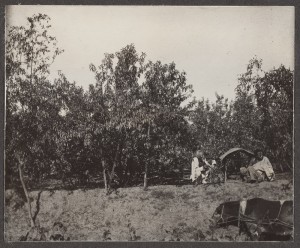While Luigi was getting excited about giant parsley, frequent tipster Dirk Enneking sent word of giant peaches, a much tastier quarry. The great plant explorer Frank Nicholas Meyer traveled widely in the east and sent many collections back to the USDA, his employer. 1 He wrote a wonderful account of his Agricultural Explorations in the Fruit and Nut Orchards of China, published in March 1911 (and, gloriously, available thanks to Google.) Meyer describes the diversity of Chinese peaches, singling one out for special praise.
The best of them all is the “Fei Tau,” or Fei peach, Feitcheng being the name of the village where the orchards are located. These peaches grow to a large size, often weighing over 1 lb apiece, and are of a soft, pale-yellowish colour externally, with a slight blush on one side. The meat is white except near the stone, where it is slightly red. The fruit is a clingstone, with a very large, pointed stone. The skin is very downy. The fruit ripens in the early and middle part of October and has an excellent flavor, being sweet and aromatic. It possesses extraordinary keeping and shipping qualities, keeping until February if wrapped in soft tissue paper. Its shipping qualities are such that it is carried in baskets, slung on poles across the shoulders of coolies, from Feitcheng to Peking, a journey of eight days on foot. So famous is this peach, that it is sent every year as a tribute or present to the imperial court at Peking; and even right on the spot where this fruit grows the most perfect specimens retail at from 10 to 15 cents in Mexican money, a price which is about two-thirds of the average daily wages of the Chinese field laborer.
I want to try one of those! How many of the varieties Meyer mentioned are still available in China?

Whether you think Meyer’s comment says more about low wages than high prices, the fact impressed Meyer enough to note it. But why were they using “Mexican money”? Meyer describes lots more peach diversity.
Some of these peaches are blood red and when cut through look more like a beet root than anything else. One variety in Shansi is even called the “Rho Tau,” or beef peach, so much does it resemble meat.
He also mentions flat peaches, red and white, which by the sound of it resemble the ephemeral “Saturn” peaches that briefly show up in the fruit-shops of Rome and can perfume a large room with their scent.
Meyer points out that the Chinese genetic diversity had, and in 1911 still has, a lot to offer growers in the US, and that, after all, was his job, to plunder the resources of another sovereign state and bring them back to improve US agriculture. But has anyone calculated the contribution of Chinese peaches like the ones Meyer noted to peaches in the US and elsewhere? It would be a fascinating and tasty case study.